How To Install Rtl Sdr On Raspberry Pi
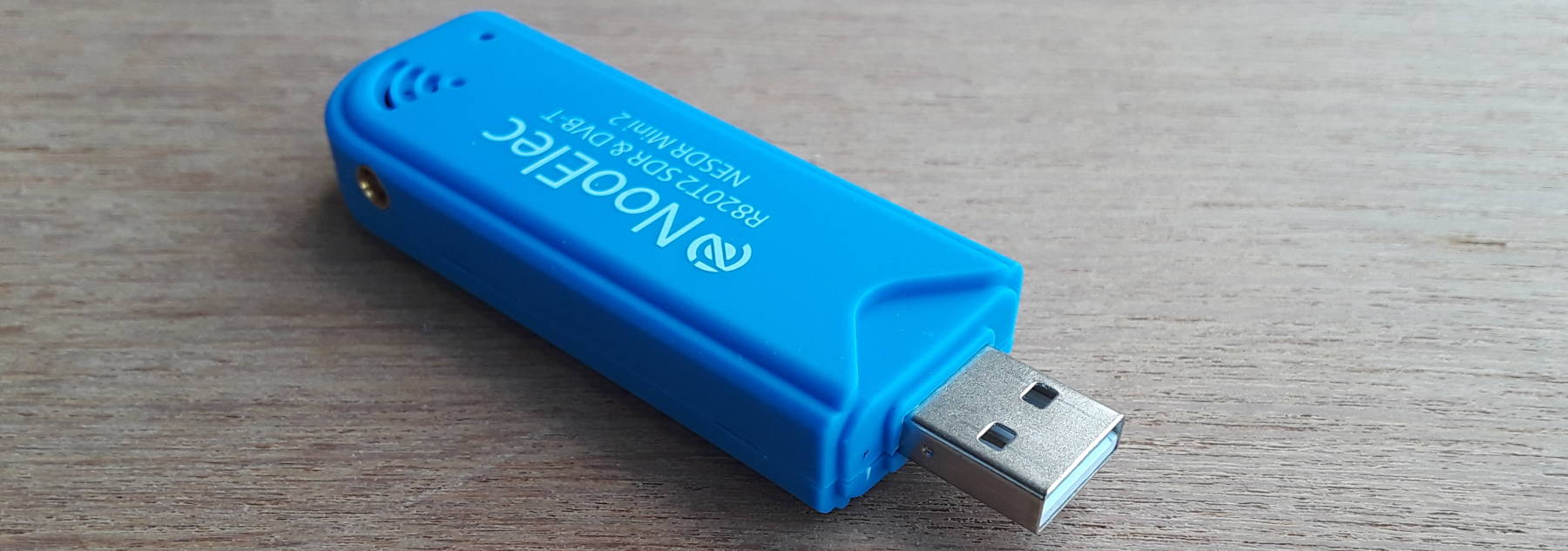
Getting Started With RTL-SDR
RTL-SDR Receiver
Hither are my notes on getting started with a newly purchased SDR stick, a software-defined radio.
I'm using the NooElec unit, which has the R820T2 receiver. Information technology has what seems to me to be the best frequency range.
It'south very easy to use with Linux, on a Raspberry Pi, laptop, or desktop.

This ane came with a telescoping antenna, which could make some initial experiments more successful.
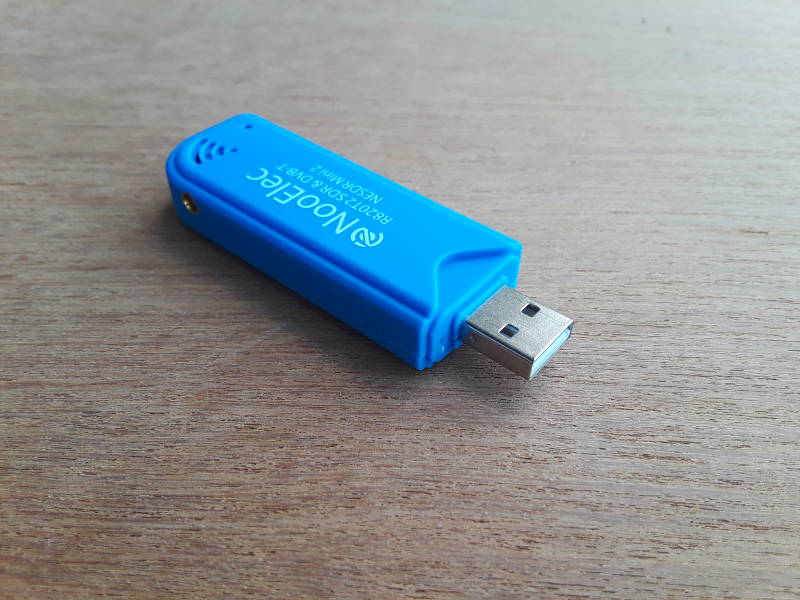
Eventually, though, I'll use it with a 6-inch RG316 cable with male MCX and female F connectors. So, a converter from F to BNC.
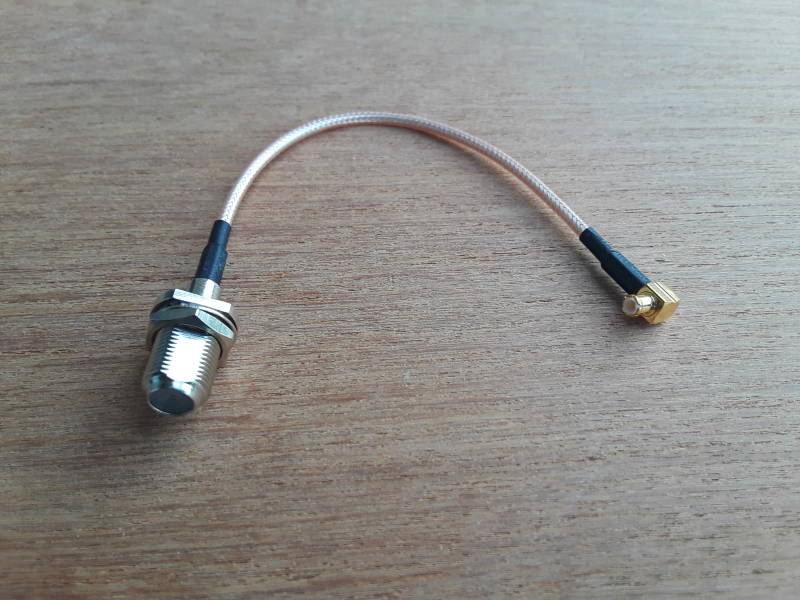
The great thing about these small SDR units is the radio capability you go for the price.
They're bachelor at a depression price considering they're intended for a rather big market: DVB-T or Digital Video Dissemination — Terrestrial. That standard is used across Europe, Asia outside China, Oceania, and Africa, plus Columbia in South America and some of the Caribbean.
Otherwise, terrestrial television circulate is mostly ATSC in North America, and ISDB in Nippon and about of South America. Hither'south a map of digital terrestrial TV standards from Wikipedia.

How is it Detected?
Linux has good support for these devices. The problem is that they will be detected as DVB-T devices. That makes sense, given the vast number of people wanting to watch television across much of the earth, compared to the much smaller number of us wanting to do radio experiments.
Here is the result of plugging the device into a Linux system. Kickoff, the new additions to the kernel ring buffer. I accept highlighted what the dvb_usb_v2/dvb_usb_rtl28xxu kernel module has done:
$ dmesg [ ... earlier entries deleted ... ] [23499.940052] usb 1-3: new loftier-speed USB device number two using ehci-pci [23500.107969] usb 1-3: New USB device found, idVendor=0bda, idProduct=2838 [23500.107972] usb 1-three: New USB device strings: Mfr=1, Production=2, SerialNumber=3 [23500.107974] usb i-3: Product: RTL2838UHIDIR [23500.107976] usb i-3: Manufacturer: Realtek [23500.107978] usb 1-iii: SerialNumber: 00000001 [23501.432616] usb i-3: dvb_usb_v2: found a 'Realtek RTL2832U reference design' in warm state [23501.492359] usb ane-iii: dvb_usb_v2: will pass the complete MPEG2 ship stream to the software demuxer [23501.492376] dvbdev: DVB: registering new adapter (Realtek RTL2832U reference design) [23501.899098] i2c i2c-viii: Added multiplexed i2c bus nine [23501.899101] rtl2832 8-0010: Realtek RTL2832 successfully fastened [23501.899215] usb 1-iii: DVB: registering adapter 0 frontend 0 (Realtek RTL2832 (DVB-T))... [23502.023731] r820t 9-001a: creating new instance [23502.030729] r820t 9-001a: Rafael Micro r820t successfully identified [23502.064338] media: Linux media interface: v0.10 [23502.082239] Linux video capture interface: v2.00 [23502.237918] rtl2832_sdr rtl2832_sdr.2.automobile: Registered equally swradio0 [23502.237921] rtl2832_sdr rtl2832_sdr.2.car: Realtek RTL2832 SDR fastened [23502.237923] rtl2832_sdr rtl2832_sdr.two.auto: SDR API is still slightly experimental and functionality changes may follow [23502.403973] lirc_dev: IR Remote Control driver registered, major 242 [23502.421987] IR LIRC bridge handler initialized [23502.422271] Registered IR keymap rc-empty [23502.422332] rc rc0: Realtek RTL2832U reference design equally /devices/pci0000:00/0000:00:1a.7/usb1/1-3/rc/rc0 [23502.422374] input: Realtek RTL2832U reference design as /devices/pci0000:00/0000:00:1a.vii/usb1/1-3/rc/rc0/input11 [23502.423062] lirc lirc0: lirc_dev: driver ir-lirc-codec (dvb_usb_rtl28xxu) registered at minor = 0 [23502.423066] usb 1-3: dvb_usb_v2: schedule remote query interval to 200 msecs [23502.431739] usb 1-3: dvb_usb_v2: 'Realtek RTL2832U reference design' successfully initialized and connected [23502.431821] usbcore: registered new interface driver dvb_usb_rtl28xxu
At present, how information technology shows upward in the listing of USB devices:
$ lsusb [ ... other devices deleted ... ] Motorbus 001 Device 002: ID 0bda:2838 Realtek Semiconductor Corp. RTL2838 DVB-T [ ... other devices deleted ... ]
So, the kernel has detected information technology. But, from our viewpoint, incorrectly, as a DVB-T television receiver. Let's see what DVB-T-related kernel modules are loaded:
$ lsmod | egrep 'sdr|dvb' rtl2832_sdr 36864 0 videobuf2_vmalloc 16384 1 rtl2832_sdr videobuf2_v4l2 24576 i rtl2832_sdr videobuf2_core 40960 2 rtl2832_sdr,videobuf2_v4l2 videodev 184320 3 rtl2832_sdr,videobuf2_core,videobuf2_v4l2 dvb_usb_rtl28xxu 40960 1 dvb_usb_v2 40960 one dvb_usb_rtl28xxu dvb_core 126976 2 dvb_usb_v2,rtl2832 rc_core 36864 v lirc_dev,ir_lirc_codec,dvb_usb_v2,dvb_usb_rtl28xxu
Forcing Detection as SDR, Not DVB-T
We demand to blacklist the dvb_usb_rtl28xxu kernel module. Every bit root, create a new file, such every bit /etc/modprobe.d/blacklist-dvb.conf. It tin can be named anything, as long as it ends .conf, and information technology tin can comprise comments.
$ cat /etc/modprobe.d/blacklist-dvb.conf # 2022-03-23: Bob added this then RTL-SDR devices are detected as SDR, not DVB blacklist dvb_usb_rtl28xxu
You lot could reboot, or you could unplug the device and remove the DVB-T modules:
$ sudo rmmod rtl2832_sdr dvb_usb_rtl28xxu dvb_usb_v2 rtl2832 dvb_core $ lsmod | egrep 'sdr|dvb' [ ... no output, that's expert ... ] Now plug it back in and check the kernel ring buffer, and encounter how it is recognized. The first there lines beneath evidence the results of the rmmod command (light blue), then one event unplugging the device (light yellowish), and so several lines after plugging it back in under the new configuration (light green):
$ dmesg [ ... earlier entries deleted ... ] [23780.744989] usbcore: deregistering interface commuter dvb_usb_rtl28xxu [23780.746936] r820t 9-001a: destroying example [23780.747131] dvb_usb_v2: 'Realtek RTL2832U reference blueprint:i-3' successfully deinitialized and disconnected [23867.981942] usb 1-3: USB disconnect, device number 2 [23874.456050] usb one-3: new high-speed USB device number 3 using ehci-pci [23874.624042] usb 1-3: New USB device institute, idVendor=0bda, idProduct=2838 [23874.624045] usb i-3: New USB device strings: Mfr=i, Production=2, SerialNumber=three [23874.624047] usb one-iii: Product: RTL2838UHIDIR [23874.624049] usb 1-three: Manufacturer: Realtek [23874.624051] usb 1-3: SerialNumber: 00000001
Testing with rtl_test
At present let's examination the device. Install the rtl-sdr bundle if needed. Printing <Ctrl-C> once you see the bulletin almost everything beingness fine if there's no farther output.
$ rtl_test Establish 1 device(s): 0: Realtek, RTL2838UHIDIR, SN: 00000001 Using device 0: Generic RTL2832U OEM Found Rafael Micro R820T tuner Supported gain values (29): 0.0 0.ix 1.iv 2.seven 3.7 vii.7 eight.7 12.5 14.four fifteen.vii 16.6 nineteen.seven 20.7 22.9 25.4 28.0 29.7 32.8 33.eight 36.iv 37.2 38.half-dozen forty.2 42.i 43.4 43.9 44.5 48.0 49.6 [R82XX] PLL not locked! Sampling at 2048000 Southward/s. Info: This tool will continuously read from the device, and report if samples get lost. If you observe no further output, everything is fine. Reading samples in async mode... ^CSignal caught, exiting! User abolish, exiting... Samples per meg lost (minimum): 0
Using the SDR with GQRX
Install the gqrx bundle if yous haven't notwithstanding. It uses GnuRadio, with an easy interface.
Information technology is easy to accidentally plow the gain off. If your receiver goes deaf, as shown beneath, click the Input controls tab.
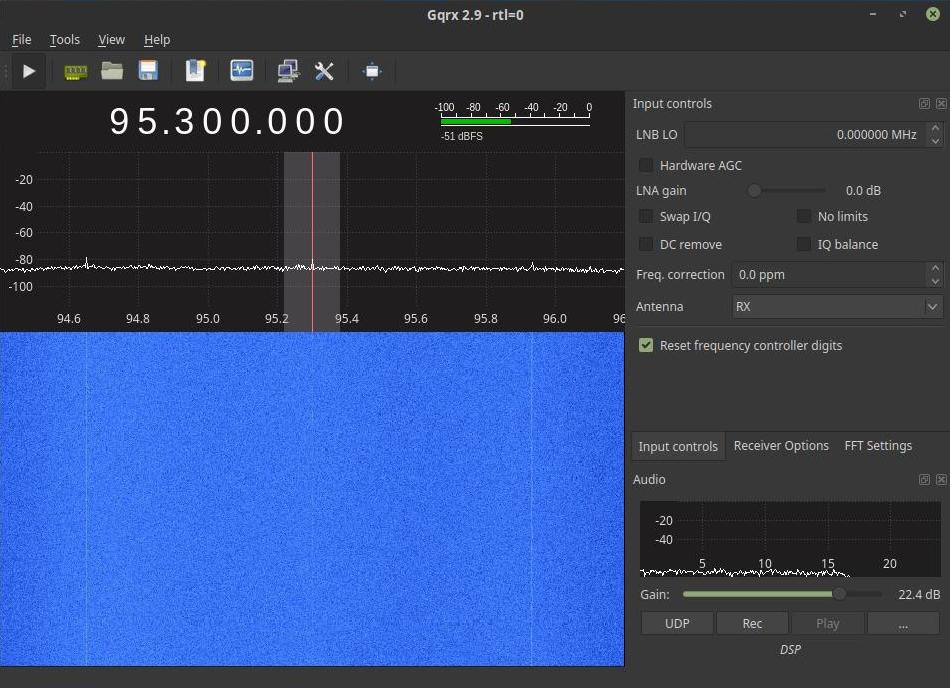
If you toggle Hardware AGC off and on it may also gear up the LNA proceeds to nix.
Turn Hardware AGC off and then y'all tin can adjust the proceeds, slide the proceeds to the maximum, and then turn AGC dorsum on again.
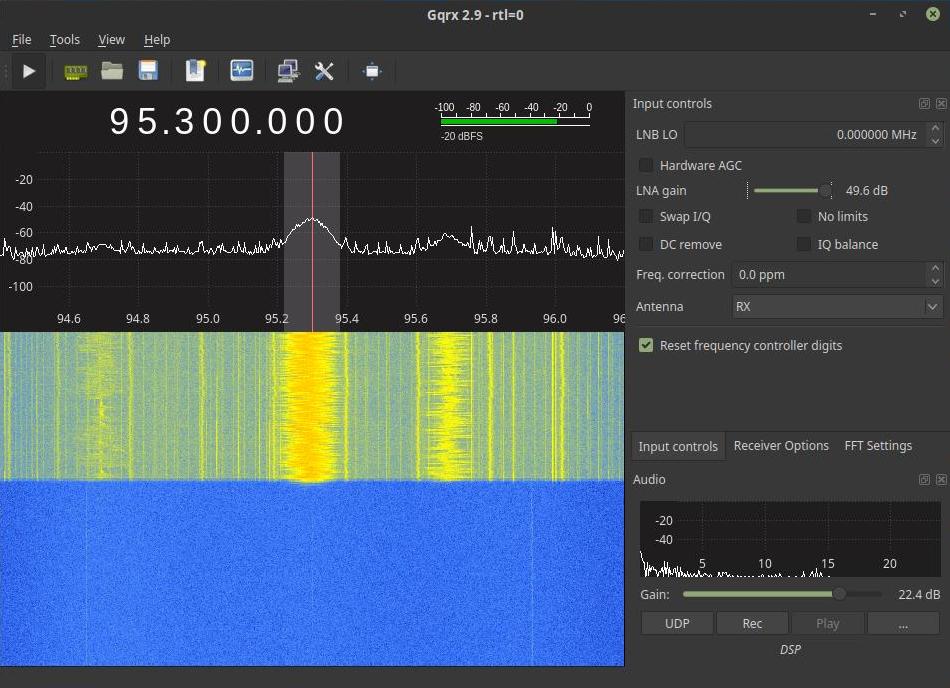
Y'all should see multiple signals on the FM circulate band. Select Wide FM (stereo) under Receiver Options to also hear them.
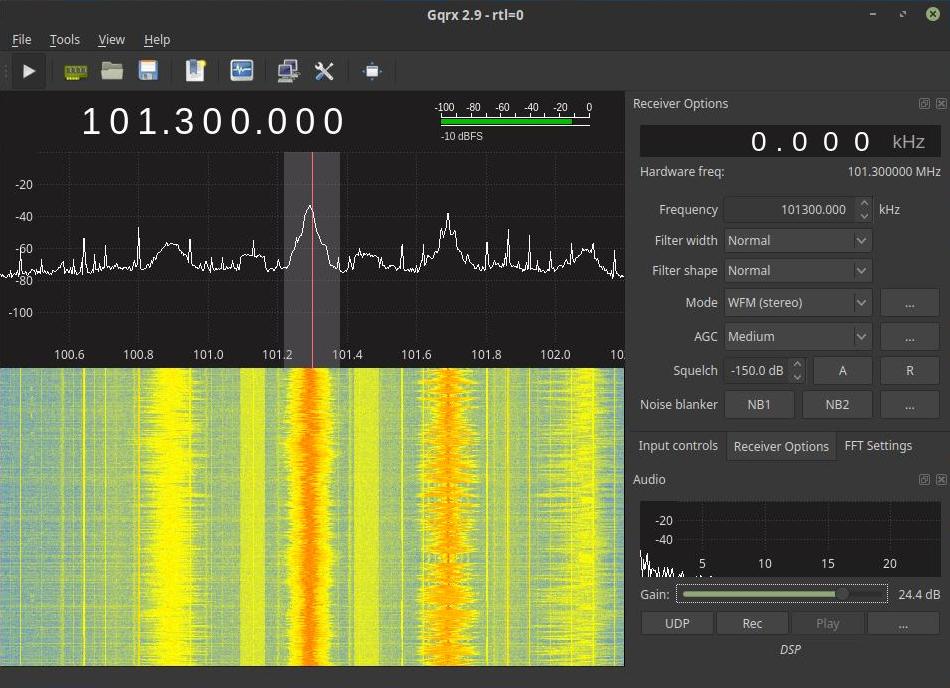
Higher up is the 101.3 MHz signal of WBAA, the NPR station at Purdue Academy. WBAA broadcasts in Hd Radio, an in-band on-channel organisation with digital streams immedately above and below the analog signal. FCC records tell us that the signals visible here are:
| Frequency | Callsign | Distance | Power | Location |
| 100.9 MHz | WHPO | 66.9 km | 3,000 Westward | Hoopeston IL |
| W265CP | 37.five km | 27 W | Buffalo IL | |
| 101.3 MHz | WBAA | 14.3 km | 14,000 W | West Lafayette IN |
| 101.7 MHz | W272CZ | 57.4 km | xxx W | Sheridan IN |
| W269DJ | 5.four km | 250 Westward | Lafayette IN | |
| WIVR | 75.3 km | three,200 W | Kentland IN | |
| 102.1 MHz | WDNL | 68.4 km | 50,000 West | Danville IL |
| W271BX | 35.nine km | 129 W | Frankfort IN |
Religious broadcast companies similar Calvary Radio Network and the Elohim Grouping operate a lot of low-ability translator systems.
As for the amateur bands, y'all could see activity. I'thou only seeing spurious signals hither.
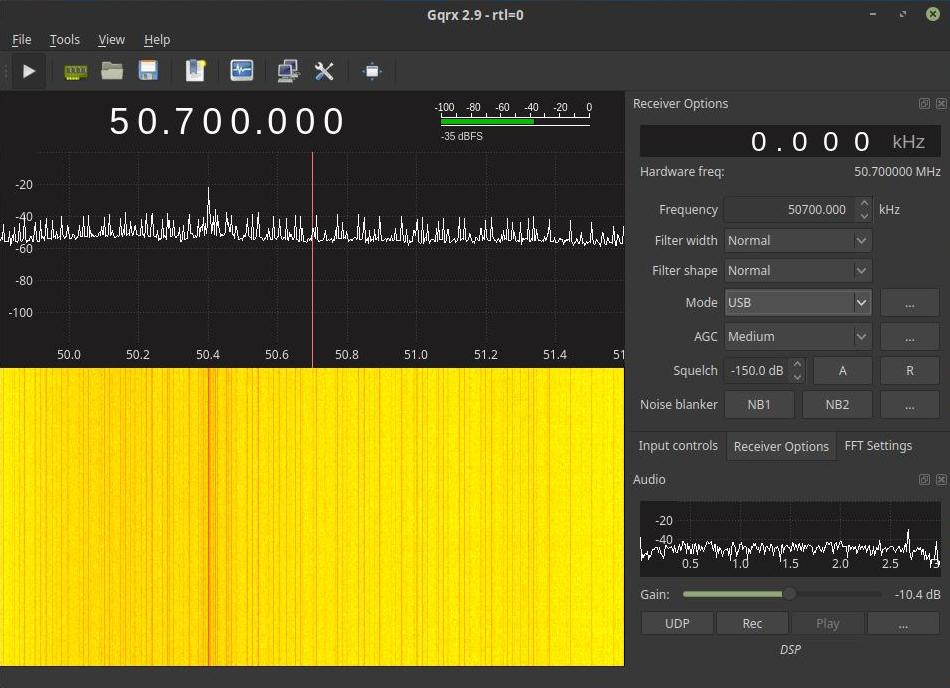
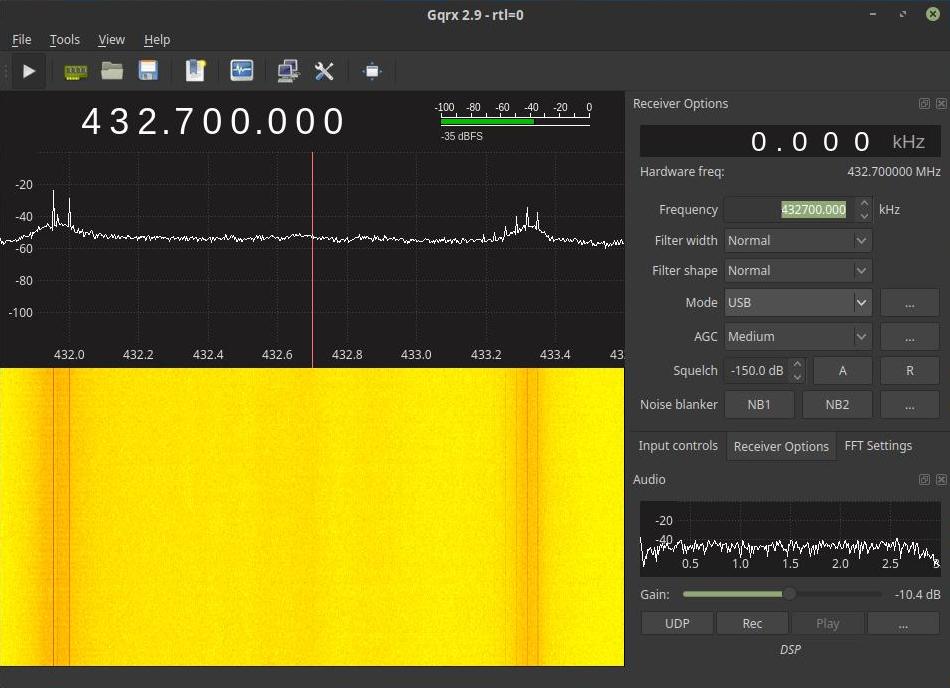
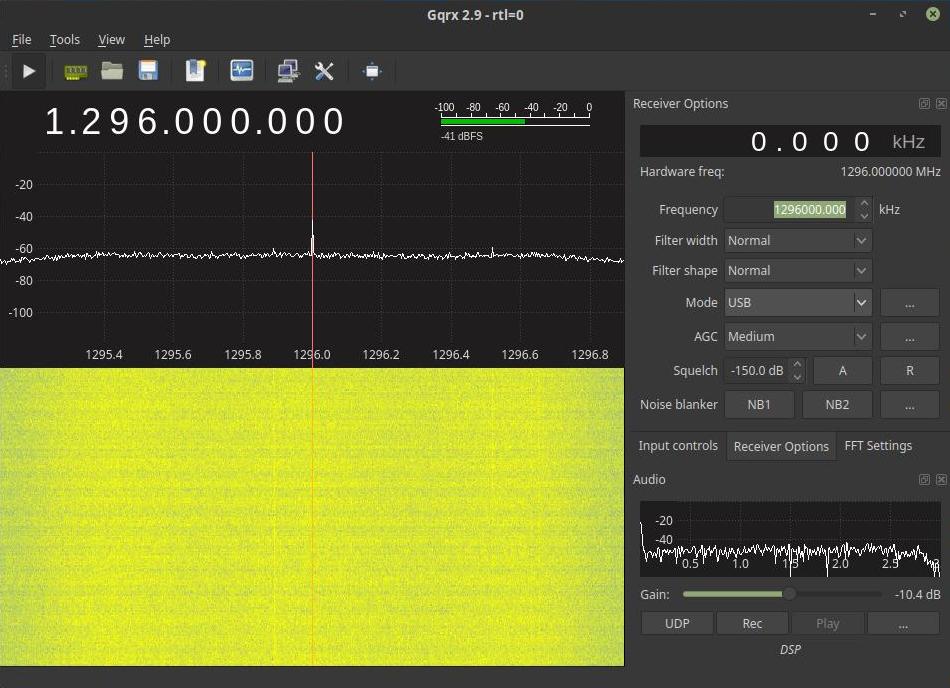
The RTL-SDR sticks are based on the RTL2832U chipset. They come up with dissimilar tuner chips, providing different frequency ranges.
| Tuner chip | Frequency range |
| Rafael Micro R820T/2 | 24 – 1766 MHz An experimental driver may extend that to 24 — 1864 MHz. |
| Elonics E4000 | 52 – 2200 MHz With a varying gap around 1100 – 1250 MHz. Notation that Elonics has ceased production. |
| Fitipower FC0013 | 22 – 1100 MHz |
| Fitipower FC0012 | 22 – 948.half-dozen MHz |
| FCI FC2580 | 146 – 308, 438 – 924 MHz |
The RTL2382U chipset can sample at 2.four megasamples per second without dropping samples. Your unit may be able to sample at 2.8 MS/s or even three.two MS/s.
Yous might also exist interested in:
Contrary-engineered RTL2832U / R820T circuit diagram and performance notes R820T datasheet
Select a Raspberry Pi topic:
Back to the Linux / Unix page Radio TopicsSource: https://cromwell-intl.com/open-source/raspberry-pi/sdr-getting-started.html
Posted by: lewisyedis1951.blogspot.com


0 Response to "How To Install Rtl Sdr On Raspberry Pi"
Post a Comment